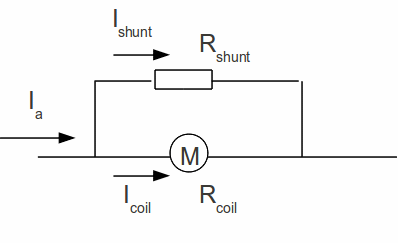An ideal ammeter has zero resistance, because then it has no effect on the circuit, the current in which it is measuring. Real ammeters have small but finite resistances.

We can use any meter in principle to measure any current no matter how large by connecting in parallel with a shunt resistance![]()
Since the shunt and the coil are in parallel, the voltage across each is the same:
![]()
But![]() so
so ![]()
To find the shunt resistance![]() we rearrange this to give
we rearrange this to give![]()
Suppose we want to use a meter to measure currents of up to 50 mA, and we have a meter that gives a full scale deflection for currents of 1 mA or less and has a resistance of![]()
![]()
A series of shunts may be fitted in meters so they may accurately measure currents over differing ranges, with the user able to switch between ranges.
